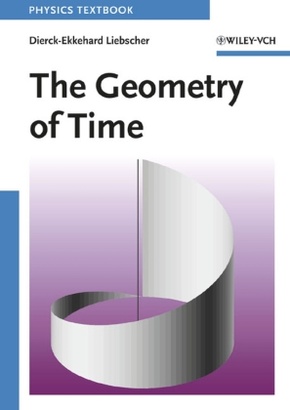The Geometry of Time
| Verlag | Wiley-VCH |
| Auflage | 2005 |
| Seiten | 241 |
| Format | 17,0 x 24,2 x 1,3 cm |
| Gewicht | 502 g |
| Artikeltyp | Englisches Buch |
| ISBN-10 | 3527405674 |
| EAN | 9783527405671 |
| Bestell-Nr | 52740567A |
"The Geometry of Time" beschreibt die Raum-Zeit-Geometrie, und zwar insbesondere die Spezielle Relativitätstheorie mit allen Fragen und Problemen, die schwer zu verstehen sind, wenn sie nur anhand von Formeln erklärt werden.
Der Band zeigt auf, dass es sich bei der Raum-Zeit-Geometrie tatsächlich um Geometrie handelt, mit echten geometrischen Konstruktionen, wie wir sie von der Euklidischen Geometrie her kennen. Geometrie, die exakte Demonstrationen und Beweise erlaubt. Die Beziehung zur projektiven Geometrie wird aufgezeigt und benutzt, um die Anfänge der allgemeinen Relativität anschaulich darzustellen.
Dieses Lehrbuch wurde nicht nur als Einführung in die Relativitätstheorie konzipiert, damit der Leser formales Rechnen lernt. Seine Aufgabe besteht vielmehr darin, die Verbindung der Speziellen Relativität zur Synthetischen Geometrie aufzuzeigen, was in der gängigen Fachliteratur häufig vernachlässigt wird.
Die formale Mathematik, die bei den hier behandel ten Konstruktionen zur Anwendung kommt, findet der Leser in Spezialanhängen.
Dieser Einführungsband richtet sich in erster Linie an Studienanfänger und fortgeschrittene Studenten.
A description of the geometry of space-time with all the questions and issues explained without the need for formulas. As such, the author shows that this is indeed geometry, with actual constructions familiar from Euclidean geometry, and which allow exact demonstrations and proofs. The formal mathematics behind these constructions is provided in the appendices.
The result is thus not a textbook introducing readers to the theory of special relativity so they may calculate formally, but rather aims to show the connection with synthetic geometry. It presents the relation to projective geometry and uses this to illustrate the starting points of general relativity. Written at an introductory level for undergraduates, this novel presentation will also benefit teaching staff.
Inhaltsverzeichnis:
1 Introduction
2 The World of Space and Time
2.1 Time-tables
2.2 Surveying space-time
2.3 Physical prerequisites of geometry
3 Reflection and Collision
3.1 Geometry and reflection
3.2 The reflection of mechanical motion
4 The Relativity Principle of Mechanics and Wave Propagation
5 Relativity Theory and its Paradoxes
5.1 Pseudo-Euclidean geometry
5.2 Einstein's mechanics
5.3 Energy
5.4 Kinematic peculiarities .
5.5 Aberration and Fresnel's paradox .
5.6 The net
5.7 Faster than light
6 The Circle Disguised as Hyperbola
7 Curvature
7.1 Spheres and hyperbolic shells .
7.2 The universe
8 The Projective Origin of the Geometries of the Plane
9 The Nine Geometries of the Plane
10 General Remarks
10.1 The theory of relativity .
10.2 Geometry and physics
A Reections
B Transformations
B.1 Coordinates
B.2 Inertial reference systems
B.3 Riemannian spaces, Einstein worlds
C Projective Geometry
C.1 Algebra .
C.2 Projective maps
C.3 Conic sections
D The Transition from the Projective to the Metrical Plane
D.1 Polarity
D.2 Reection
D.3 Velocity space
D.4 Circles and peripheries
D.5 Two examples
E The Metrical Plane
E.1 Classi_cation
E.2 The Metric
Exercises
References
Glossary

